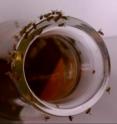The buzz around beer
Related images
(click to enlarge)
Ever wondered why flies are attracted to beer? Entomologists at the University of California, Riverside have, and offer an explanation. They report that flies sense glycerol, a sweet-tasting compound that yeasts make during fermentation. "Insects use their taste system to glean important information about the quality and nutritive value of food sources," said Anupama Dahanukar, an assistant professor of entomology, whose lab conducted the research. "Sugars signal high nutritive value to flies, but little is known about which chemical cues flies use for food sources that are low in sugar content -- such as beer."
Dahanukar's lab examined the feeding preference of the common fruit fly for beer and other products of yeast fermentation, and found that a receptor (a protein that serves as a gatekeeper) that is associated with neurons located in the fly's mouth-parts is instrumental in signaling a good taste for beer.
The receptor in question is Gr64e. Once a fly has settled on beer, Gr64e detects glycerol and transmits this information to the fly's neurons, which then influences the fly's behavioral response.
Dahanukar explained that flies use other receptors in their sensory organs to find food from a distance.
"Taste becomes important only after the fly makes physical contact with food," she said. "A fly first locates food sources using its odor receptors -- crucial for its long-range attraction to food. Then, after landing on food, the fly uses its taste system to sample the food for suitability in terms of nutrition and toxicity."
Dahanukar, a member of UCR's Institute for Integrative Genome Biology, explained that taste receptors also come into play when a female fly has to locate a suitable site for laying eggs.
"Females come to a decision after they have conducted intense probing of various potential sites," she said.
Study results appeared online Nov. 6 in Nature Neuroscience.
Dahanukar was joined in the project by Zev Wisotsky, Adriana Medina, and Erica Freeman -- all of whom work in her lab.
Wisotsky, a neuroscience graduate student and the first author of the research paper, performed the imaging, taste electrophysiology and behavior experiments. He was joined in his efforts by Freeman, a bioengineering graduate student, who performed the olfactory recordings; and Medina, a junior specialist in entomology, who performed the feeding preference experiments and molecular analysis.
The lab is poised now to move the research forward.
"How do you get information from the chemical environment to the brain -- not just in flies but other insects as well?" Dahanukar said. "How is that information processed to give rise to appropriate behavior? How does feeding behavior change with hunger? These are some questions we would like pursue."
The research project was supported in part by a Whitehall Foundation research grant to Dahanukar and a fellowship from the National Science Foundation Integrated Graduate Education Research and Training Program in Video Bioinformatics to Freeman.
Source: University of California - Riverside
Other sources
- The buzz around beer: Why do flies like beer?from Science DailyFri, 18 Nov 2011, 1:31:02 UTC
- The buzz around beerfrom Science BlogThu, 17 Nov 2011, 18:20:18 UTC
- The buzz around beerfrom PhysorgThu, 17 Nov 2011, 17:01:11 UTC


